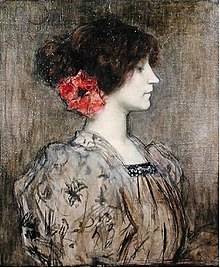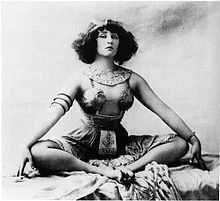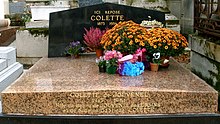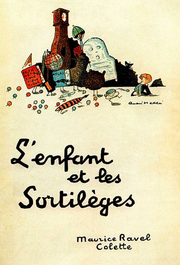Colette
Colette (actually Sidonie-Gabrielle Claudine Colette ; born January 28, 1873 in Saint-Sauveur-en-Puisaye , Département Yonne ( Burgundy ); † August 3, 1954 in Paris ) was a French writer , variety artist and journalist . She was the first woman in France to have a state funeral .
Life and work
Youth and first marriage
Colette grew up as the youngest of four half-siblings and siblings in Bourgogne , where her father, an officer retired because of war injuries, was a tax collector. Unlike the three older siblings, she did not go to secondary school, but was encouraged by her father, who was interested in literature, and above all by her clever and understanding mother, with whom she later stayed in close correspondence.

During a trip to Paris in 1889, at the age of 16, she met 30-year-old Henry Gauthier-Villars , who had already made a certain name for himself there as a man of letters and salon lion. In 1893 she married him and was trained and used by him, who quickly recognized her talent for writing. Under his pseudonym “Willy” she wrote a series of increasingly successful novels from 1896, which tell the story of a young woman in the first person and with many autobiographical elements: Claudine à l'École, Claudine à Paris, Claudine en Ménage and Claudine s'en va (published 1900 to 1903; in the German translation today published as Claudine awakes, Claudine in Paris, Claudine in marriage and Claudine leaves ). Soon after her last Claudine novel (1903), Colette divorced “Willy”, who was repeatedly unfaithful to her, but who knew how to secure the author's rights to the Claudines . In 1907 she was to publish a continuation of the series with La Retraite sentimentale (Eng. Claudine finds herself ), which in 1922 she was finally to extend into the Burgundian childhood of her heroine with La Maison de Claudine (Eng: my parents' house , later Claudine's girlhood ) .
Variety career, relationships with women

After the divorce, Colette lived with Natalie Clifford Barney for a while . The two had a brief affair and remained friends until Colette's death. During this time she also took lessons with the pantomime Georges Wague and from 1906 toured for six years with mimodramas on numerous vaudeville stages in Paris and the provinces. Here she often performed together with Mathilde ("Missy") de Morny , ten years her senior , the very unconventionally living daughter of a half-brother of Napoléon III. , on. When the two kissed in the Moulin Rouge in 1907 while performing a pantomime called Rêve d'Égypte , there was a commotion, which the police had to be called to settle. In the wake of the scandal, further performances of the play were banned and Colette and Missy could only continue their relationship, which lasted five years, only covertly.
In 1909 she began another autobiographical novel, La Vagabonde (“The Vagabond”), in which she portrayed in the first person the existence of a disappointed divorced wife, variety artist and adored of a rich heir (her own short-lived relationship with the millionaire heir Auguste-Olympe Hériot, who took her on a trip to Italy in 1910, was apparently only after the novel). La Vagabonde , which initially appeared in the feature section of a magazine, was shortlisted for the prestigious Prix Goncourt literary prize in 1910 and marked Colette's breakthrough as an author.
Further literary activity, second marriage
She was also wanted as a journalist and was given her own section in the features section of the Paris daily Le Matin . From 1911 she lived with the editor-in-chief of the paper, the also divorced Baron Henry de Jouvenel des Ursins (born 1876), whom she married in late 1912. Shortly before, her mother died, after which her half-brother burned the daughter's 2000 letters to her. In 1913, she processed her previous life in the Variété again to the autobiographical novel L'Envers du music-hall ("The flip side of the Variétés"; first published in German by Paul Zsolnay Verlag in Vienna as a comedian , which provoked the author's insistent protest).
The outbreak of World War I in August 1914 was also a deep turning point for Colette: Jouvenel was drafted into the military, but did not have to go to the front, but instead held higher positions in the government. In the meantime, after she had sent her daughter, born in 1913, together with the governess to a Jouvenel estate in Castel-Novel in Varetz (near Brive-la-Gaillarde ), she worked as a nurse in the exuberance of general enthusiasm for the war, first in Paris, then in a military hospital near Verdun . In 1915 she traveled to Italy, allied with France against Germany and Austria, as a reporter for Le Matin , for whom she also wrote over the next few years. In early 1917 she accompanied Jouvenel to Rome, who was representing France at a conference there. It was here that La Vagabonde was filmed in her presence and based on a script written by her .
Back in Paris, she began a new novel, Mitsou, ou Comment l'esprit vient aux filles (for example, "Mitsou, or How a light goes on for young girls"), which appeared in 1919. In the same year she became the head of the literary features of the Matin . In 1919/20 she also wrote her best-known novel Chéri (“Darling”), the story of an ultimately impossible love between a young man and an older woman. The first idea for this book had come to her in 1912, but the topic was particularly close to her now, because she had just started a relationship with her stepson Bertrand de Jouvenel (born 1903). In 1921, Chéri was turned into a play by her and a co-author , in which she often played the role of the female protagonist for the 100th performance, but also later .
In the meantime her husband had made a career as a politician, and she too had achieved social honors: in 1920 she had been made Knight of the Legion of Honor ; later she was even promoted to officer (1928) and commander (1936). Their marriage, however, fell apart, because Jouvenel also proved to be unfaithful and left them in 1923. However, she still spent a lot of time at Château Castel-Novel, where some of her works were also created.
In 1922 the feature section of Le Matin began to print her little novel Le Blé en herbe ("Unripe Grain"; Eng. Later published as Awakening Hearts ), which revolves around the topic of the sexual initiation of a young person by an older woman. However, the reprint had to be canceled due to the moral indignation of many readers of the newspaper. When the work was published in book form in 1923, she first used the simple "Colette" as the author's name.
The later years

After the end of the relationship with her stepson, in 1925 she met the also much younger rich pearl dealer Maurice Goudeket (born 1889), with whom she initially often went on long trips and whom she married in 1935. From 1939 she suffered from progressive osteoarthritis of the hip joints , which made life difficult for her and increasingly confined her to her apartment. An autobiographical text printed in 1941 was accordingly called De ma fenêtre (Eng. Paris through my window ). During the German occupation of northern France and the anti-Semitic actions of the French Vichy government, she managed to free her Jewish husband from prison and to help him go into hiding.
In 1942 she achieved one of her greatest successes with the short feature novel Gigi , which was printed as a book in 1944 and was the template for the musical film of the same name from 1958, the adaptation of which for the stage premiered on Broadway in 1973. The novel is about the advantageous marriage of a pretty young girl with an older man and takes the author and reader from the Second World War back to better times, namely the Belle Époque around 1900.
Gradually, Colette became the (long also wealthy) grand old lady of French literature in the first half of the century. She wrote and published, was read and filmed, gave lectures and traveled, honored like no other writer before her. In 1945 she became the second woman to be one of the ten members of the Académie Goncourt , and in 1949 its chairman. On the other hand, the Académie française could not decide to accept it. From 1948 to 1950 a complete edition of her works was published in 15 volumes by Goudeket. Her 80th birthday in 1953 was a national event, and when she died in 1954, she was given a pompous state funeral.
Above all, Colette knew how to describe female characters and the fate of women in her novels in a psychologically sensitive and realistic way. Her unconventional lifestyle was also reflected in her works, in particular in the fact that she critically deals with marriage and does not taboo on woman's sexuality. With her work Le Pur et l'Impur from 1932 ( Eng . The joys ) Colette intended to create a counterpart to Sodome et Gomorrhe (1924) by Proust from the perspective of female experience.
In the two novels La maison de Claudine (1922) and Sido (1929), she set a monument to her idiosyncratic nature-loving mother. Although it was highly valued by many readers and fellow authors, it was for a long time traded under value by university literary critics. In 1953 she was elected Grand Officier of the Legion of Honor and an honorary foreign member of the American Academy of Arts and Letters .
Works (in selection)
- Claudine à l'École , Roman, 1900 (German Claudine awakes , in: Claudine , translated by Lida Winiewicz, Zsolnay, Vienna 1957)
- Claudine à Paris , Roman, 1901 (German Claudine in Paris , in: Claudine , translated by Lida Winiewicz, Zsolnay, Vienna 1957)
- Claudine en Ménage , Roman, 1902 (German first as Claudine's marriage , translated by Georg Nördlinger, G. Grimm, Budapest 1902; then as Renaud's wife. A marriage novel , translated by Nina Carolus, Wendt & Co., Dresden 1927; later as Claudine in the marriage , in: Claudine , translated by Lida Winiewicz, Zsolnay, Vienna 1957)
- Claudine s'en va , Roman, 1903 (German initially as Claudine goes. Annie's diary , translated by Georg Nördlinger, G. Grimm, Budapest 1903; later as: Claudine goes , in: Claudine , translated by Lida Winiewicz, Zsolnay, Vienna 1957)
- Sept dialogues de bêtes (later Dialogues de bêtes ), 1904 (German as Seven Animal Dialogues , translated by Emmi Hirschberg, G. Kiepenheuer, Potsdam 1928)
- La Retraite sentimentale , Roman, 1907 (German initially as Claudine's Retraite sentimentale , translated by Erika Danneberg, Zsolnay, Vienna 1958; later as Claudine finds herself , Rowohlt, Reinbek 1961)
- Les Vrilles de la vigne , Collection of short stories, 1908
- L'Ingénue libertine , Roman, 1909 (German: Dreamed Sins , translated by Hans B. Wagenseil, Transmare, Berlin – Düsseldorf 1949)
- La Vagabonde , Roman, 1910 (nominated for the Prix Goncourt ; German initially as Renée Néré. The fate of a woman . Transl. Rosa Breuer-Lucka. Zsolnay, Vienna 1927; later as La Vagabonde . Transl. Grit Zoller, German, Munich 1987)
- L'Entrave , Roman, 1913 (German: Die Fessel , translated by Erna Redtenbacher, Zsolnay, Vienna 1928)
- L'Envers du music-hall , autobiographical novel, 1913 (German comedians. My companions and I , translated by Erna Redtenbacher, Zsolnay, Berlin – Vienna – Leipzig 1931, later as Wir Komödianten vom Variété. Meine companions and I , ibid. , 1952)
- La Paix chez les bêtes , Roman, 1916 (German. Peace among the animals . Translated by Erna Redtenbacher, Helene M. Reiff. Zsolnay, Berlin – Vienna – Leipzig 1931)
- Mitsou ou Comment l'esprit vient aux filles , Roman, 1919 (Ger. Mitsou , transl. Erna Redtenbacher. Zsolnay, Vienna 1927, excerpt from The Great Masters. European Narrators of the 20th Century, Vol. 2. Ed. Rolf Hochhuth . Bertelsmann Lesering o. J. (1966), pp. 91 - 141; newly translated by Alexandra Auer, Fischer TB, Frankfurt am Main 2000)
- Chéri , Roman, 1920 (German Chéri , translated by Hans Jacob, C. Weller & Co., Leipzig 1927; newly translated by Roseli and Saskia Bontjes van Beek, Zsolnay, Vienna 1997)
- La Maison de Claudine (1922; German initially as Mein Elternhaus , translated by Erna Redtenbacher, Zsolnay, Berlin – Vienna – Leipzig 1929, later under the title Claudines Mädchenjahre , Zsolnay, Vienna, 1960)
- Le Blé en herbe , Roman, 1923 (German initially as Phil and Vinca , translated by Lissy Radermacher, G. Kiepenheuer, Potsdam 1927; later as Awakening Hearts . About Stefanie Neumann, Zsolnay, Vienna 1952)
-
L'enfant et les sortilèges , "fantaisie lyrique" (music: Maurice Ravel . Premiere: March 21, 1925, Opéra de Monte-Carlo )Title page of the piano reduction by L'enfant et les sortilèges with an illustration by André Hellé (1925)
- La Fin de Chéri , Roman, 1926 (German: Chéri's Ende , translated by Hans Jacob, Paul Neff, Berlin – Leipzig 1927; newly translated by Roseli and Saskia Bontjes van Beek, Zsolnay, Vienna 1997)
- La Naissance du jour , Roman, 1928 (German first as daybreak , translated by Erna Redtenbacher and Helene M. Reiff, Zsolnay, Berlin – Vienna – Leipzig 1928; later as Die Freuden des Lebens , Zsolnay, Vienna 1961)
- La Seconde , Roman, 1929 (German: The Other , translated by Erna Redtenbacher, Zsolnay, Berlin – Vienna – Leipzig 1930)
- Sido , Roman, 1930 (German Sido , translated by Doris Brehm, Zsolnay, Vienna 1961; newly translated by Uli Aumüller, Rowohlt, Reinbek bei Hamburg 1982)
- Le Pur et l'Impur (first published as Ces plaisirs ... ), 1932 (German. These joys , translated by Maria Dessauer, Suhrkamp, Frankfurt am Main 1983, ISBN 3-518-01717-9 )
- La Chatte , Roman, 1933, (German initially as The Cat , translated by Elisabeth Seeger, with drawings by Grete Mikeska-Schmied, Zeitbild-Verlag / Volckmar, Leipzig-Vienna 1936; later as Jealousy , translated by Emi Ehm, Zsolnay, Vienna 1959; newly translated under the same title by Elisabeth Roth, published by Zsolnay, Vienna, and Deutsche Buchgemeinschaft, Berlin 1986)
- Duo , Roman, 1934 (German duet , translated by Gertrud von Helmstatt and Gisela Bonn, Weller, Konstanz 1948; newly translated by Lida Winiewicz, Zsolnay, Vienna 1959)
- Le Toutounier , novel (continuation of Duo ), 1939
- Chambre d'hôtel and La Lune de pluie , two short stories, 1941
- Julie de Carneilhan , Roman, 1941 (German: Julie de Carneilhan , translated by Ursula Seyffarth, Drei-Säulen-Verlag, Bad Wörishofen 1951; the same translation then appeared as The First Madame d'Espivant , Zsolnay, Vienna 1960)
- Journal à rebours , 1941
- De ma fenêtre , autobiography, 1942 (also as Paris, de ma fenêtre , 1944; German Paris through my window , translated by Gritta Baerlocher, with illustrations by J.-M. Moll, Pan-Verlag, Zurich 1946)
- Le Képi , Roman, 1943
- Nudité , with twenty drawings by Carlègle, 1943
- Gigi , Roman, 1944 (German Gigi , translated by Stefanie Neumann, Zsolnay, Vienna 1953)
- Trois… six… neuf , 1944 (German three… six… nine , translated by Noa Elisabeth Kiepenheuer, Kiepenheuer, Weimar 1950)
- L'Étoile Vesper , novel, 1947
- Le Fanal bleu , novel, 1949
- Paradis terrestre , novel, 1953
Published posthumously :
- Belles seasons . Flammarion, Paris 1955
- Paysages and Portraits . Flammarion, Paris 1958
- Histoires pour Bel-Gazou , short stories (with illustrations by Alain Millerand). Hachette, Paris 1992
- Claude Pichois (Ed.): Œuvres . Three volumes, Gallimard ( Bibliothèque de la Pléiade ), Paris 2003 f., ISBN 2-07-011079-6 .
Film adaptations (selection)
- 1915: Minne - Director: André Hugon
- 1918: La Vagabonda, Italian silent film
- 1948: Gigi - directed by Jacqueline Audry
- 1950: The Naive Sinner (Minne, l'ingénue libertine) - Director: Jacqueline Audry
- 1950: Chéri - Director: Pierre Billon
- 1953: Love is Stronger (Viaggio in Italia) - Director: Roberto Rosselini
- 1954: Awakening Hearts (Le Blé en herbe) - Director: Claude Autant-Lara
- 1956: Mitsou and the Men (Mitsou) - Director: Jacqueline Audry
- 1958: Gigi , American musical film - directed by Vincente Minnelli
- 1977: Claudine at school (Claudine à l'école) - directed by Édouard Molinaro
- 1977: Claudine goes (Claudine s'en va) - Director: Edouard Molinaro
- 1977: Claudines Married Life (Claudine en menage) - Director: Edouard Molinaro
- 1977: Claudine in Paris (Claudine à Paris) - Director: Edouard Molinaro
- 1989: Awakening Hearts (Le Blé en herbe) - Director: Serge Meynard
- 1991: Colette (Becoming Colette) - Director: Danny Huston
- 1992: Bella Vista - Director: Alfredo Arias
- 2003: Colette (film biography) - Director: Nadine Trintignant
- 2009: Chéri. A Comedy of Vanities (Chéri) - Director: Stephen Frears
- 2018: Colette - The Insurgent (Colette - L'Insoumise) - Director: Cécile Denjean
- 2018: Colette - director: Wash Westmoreland
Audio books and radio plays
- 1948: Animal duet - Director: Hanns Korngiebel (radio play - RIAS Berlin )
- 2006: Chéri, read by Hannelore Elsner , Random House Audio , ISBN 978-3866041813 .
literature
- Yvonne Mitchell: Colette. A biography (= Colette: A taste for life , 1975). Translated from the English by Hanna Lux. Wunderlich, Tübingen 1977.
- Renate Baader , Dietmar Fricke (ed.): The French author. From the Middle Ages to the present . Athenaion, Wiesbaden 1979.
- Joanna Richardson: Colette. Passion and sensitivity. Translated from the English (1983) by Renate Zeschitz. Heyne (biography 125), Munich 1985.
- Eva Martin Sartori; Dorothy Wynne Zimmerman: French Women Writers: A Bio-Bibliographical Source Book . Greenwood, New York 1991.
- Herbert Lottman: Colette. A biography. Translated from the French (1990) by Roselie and Saskia Bontjes van Beek. Zsolnay, Vienna 1991.
- Judith Thurman: Colette. Novel of her life (= Secrets of the Flesh: A Life of Colette , 1999). Translated from the English by Brigitte Flickinger. Berlin Verlag, Berlin 2001.
- Sylvain Bonmariage: Willy, Colette et moi . With a foreword by Jean-Pierre Thiollet . Anagrams, Paris, 2004 (reprint), ISBN 2-914571-60-7 .
- Ralf Nestmeyer : French poets and their homes . Insel Verlag, Frankfurt am Main 2005, ISBN 3-458-34793-3 .
- Ursula Link-Heer, Ursula Hennigfeld, Fernand Hörner (eds.): Literary gender theory. Eros and society in Proust and Colette . Transcript, Bielefeld 2006, ISBN 978-3-89942-557-4 .
- Hiltrud Gnüg: Colette's “Claudine à l'Ecole”. / "Claudine awakes". A spicy schoolgirl report from a bad girl's point of view . In: rebellious, desperate, infamous. The bad girl as an aesthetic figure . Edited by Renate Möhrmann with the assistance of Nadja Urbani. Aisthesis, Bielefeld 2012, ISBN 978-3-89528-875-3 , pp. 199-216 ( table of contents as pdf ).
Individual evidence
- ^ Ralf Nestmeyer: Quiet days in Saint-Sauveur-en-Puisaye. Colette, the girl from the provinces . In: Ders .: French poets and their homes . Insel-Verlag, Frankfurt am Main 2005, ISBN 3-458-34793-3 , pp. 149-164.
- ↑ Suzanne Rodriguez: Wild Heart: A Life: Natalie Clifford Barney and the Decadence of Literary Paris . HarperCollins, New York 2002, ISBN 0-06-093780-7 , pp. 131 (English).
- ↑ Shari Benstock: Women of the Left Bank Paris, 1900-1940 . University of Texas Press, Texas 1986, ISBN 0-292-79040-6 , pp. 48-49 (English).
- ↑ a b c d e f g h i Murray G. Hall: Der Paul Zsolnay Verlag. From the foundation to the return from exile . Niemeyer, Tübingen 1994, p. 67 f. ( Google Books ).
- ↑ The title alludes to the French phrase couper le blé en herbe, "Mowing grain before it's ripe"
- ↑ "The Most Human Heart in Modern French Literature". The writer and singer Sidonie-Gabrielle Colette died on August 3, 1954, by Ariane Thomalla ( Memento of February 8, 2005 in the Internet Archive )
- ↑ Ursula Link-Heer: A woman couple in love. "Ancien Régime" - Colette and the riddle of the Ladies of Llangollen , in: Literary gender theory. Eros and Society with Proust and Colette , edited by Ursula Link-Heer, Ursula Hennigfeld and Fernand Hörner. Transcript, Bielefeld 2006, ISBN 978-3-89942-557-4 , pp. 215-236 ( table of contents as pdf ).
- ↑ Honorary Members: Sidonie Gabriel Colette. American Academy of Arts and Letters, accessed March 8, 2019 .
Web links
- Literature by and about Colette in the catalog of the German National Library
- Works by and about Colette in the German Digital Library
- Literature by and about Colette in the SUDOC catalog (Association of French University Libraries)
- Biography at Dichterinnen.de
- Article "Colette" in the names, titles and dates of French literature (main source of "Life and Work")
- Colette. In: FemBio. Women's biography research (with references and citations).
- Center d'études Colette (French)
- Rob Kieffer: An unruly child of the province , " Die Zeit ", June 4, 1993
- Works by Colette in the Gutenberg-DE project (blocked until December 31, 2024)
| personal data | |
|---|---|
| SURNAME | Colette |
| ALTERNATIVE NAMES | Colette, Sidonie-Gabrielle (full name); Willy, Colette (pseudonym); Gauthier-Villars, Sidonie Gabrielle (married name) |
| BRIEF DESCRIPTION | French writer, cabaret artist and journalist |
| DATE OF BIRTH | January 28, 1873 |
| PLACE OF BIRTH | Saint-Sauveur-en-Puisaye , Burgundy |
| DATE OF DEATH | 3rd August 1954 |
| Place of death | Paris |




